
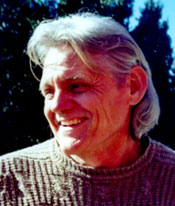
Richard Hart
"I highlight a form that wishes to emerge, allowing the natural form to clarify itself and come into being.”
Software designer and building engineer, Richard Hart was born in Austin, Texas. As a child he developed a style of ink wash which was reflective of the environment, harsh and simple, barren but with beauty.
He works with the process of bringing about—creating something from bare raw materials. The creation process is an interplay between the inherent dynamics of the materials and the attention and presence of the artist. He followed this path with mathematics and computer processing. Once linked with the Grass Valley Graphics Group, he had the opportunity to reactivate the use of this style with other media; charcoals and electronic arts as well as inkwash.
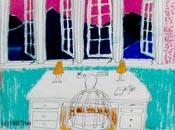
“The technique I use begins with a gesture natural to the inks without trying to impose form. There are several stages to the process. The paper is prepared with special substances, then various inks are applied without regard to the form but with regard to applying the ink to the paper with a gesture. The paper is moved so that the inks combine in a natural fashion. When the ink dries I highlight a form that wishes to emerge, allowing the natural form to clarify itself and come into being.”
In his most recent works, Hart has taken elements of his earlier abstract pieces further toward the figurative—landscapes, trees shaped by the wind and “annotated” with kryptic imaginary signs reminiscent of Chinese impressionistic watercolors. An old maple tree, bowed by centuries of wind and rain, in the simplicity and elegance of its shape, tells the story of life on this planet more eloquently than a thousand words.
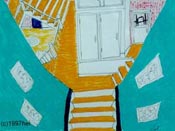
Richard Hart recalls beginning his experiments with ink wash painting as a child in grade school. “I didn’t know they were called “ink washes then,” he observes, in his Austin, Texas, drawl. He used black, red, and blue inks, with both pen and brush. He remembers most vividly painting a series of dawn and dusk landscapes, using just the three inks, which made all the colors he needed for those landscapes. Those childhood paintings began a lifelong course of experiment that has expanded its scope a great deal.
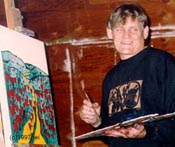
Hart’s current ink washes are still reflective of landscapes, but they may as easily be an inner or imagined landscape as the harshly beautiful hills of West Texas. He also worked the native clay there, as a teenager, and learned to make adobe bricks and build with them, when he worked on a ranch. At the University of Texas, this nascent artist and engineer studied a wide range of subjects, from philosophy and humanities to math and science. As a graduate student, he gravitated to psychology, then artificial intelligence research and information processing. His special interest was analyzing the brain’s thought processes: how do we interpret what we see, hear and touch? Hart comments, “The algorithms we developed as theory in computer modeling (in the 60’s and early 70’s) are now being widely used for practical purposes.”
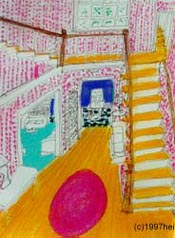
Hart sees his art as a more direct way of communicating an image or a mood than the computer programming that he does. In describing scientific work, Hart refers to analyzing or interpreting data from a phenomenon already observed that you’re trying to see more fully. His art, in contrast, creates something that didn’t exist. It brings an image into being in order to express directly to the viewer an understanding—hopefully a high aesthetic vision, or a novel viewpoint that transcends the artist’s solitude.
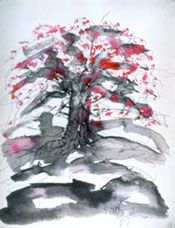
Drawn to the Sierra foothills partly by his programming career and partly by a growing association with artists of the Grass Valley Graphics Group, Hart acknowledges the importance to him of being around a group of like-minded artists. Just as the Impressionist and Expressionist painters all painted differently but inspired and influenced one another, the Grass Valley Graphics Group artists share a commitment to experiment in their art and to render in many media a deep inner vision of the world. Hart describes their association with a typically scientific analogy: Like our two eyes, which see two images that are different but alike enough to merge and provide “depth perception,” a school of artists create in individual styles but yet form a multi-faceted view that gives greater reach to all of their individual works.
Hart often creates his own works in series, exploring the possibilities of his media and spinning out the expression of a subtle, even fleeting insight. He sees his creation process as an interplay between the dynamics of the materials—which have come to include charcoals, pastels, and the electronic arts of the virtual reality spectrum—and the concentration and presence of the artist.
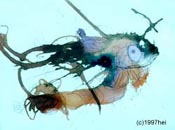
“The technique I use begins with a gesture natural to the inks without trying to impose form. The paper is prepared with special substances, then I apply various inks without regard to the form. I move the paper so that the inks combine in a natural fashion. When the ink dries, I highlight a form that wishes to emerge, allowing the natural form to clarify itself and come into being.”
For the future, Hart sees multimedia art as his medium of choice. In his videogame programming, he sees the possibility of creating a high art form, not simply a recreation or pastime for the mind alone. If sound and sight and tactile experience and smells are combined, Hart envisions an “art space” or “art field” that the observer enters. Participation can be by full immersion in the field, whether virtual reality or constructed environment—and who can predict the potential of this multimedia art form? In the hands of Richard Hart, we can be sure that the art will be a doorway to a new perception, an expression of the broader, perhaps “transpersonal,” perspective that he has always sought to capture in his art.